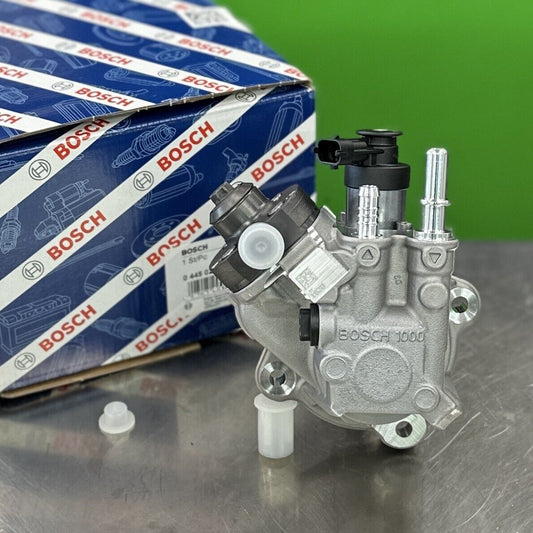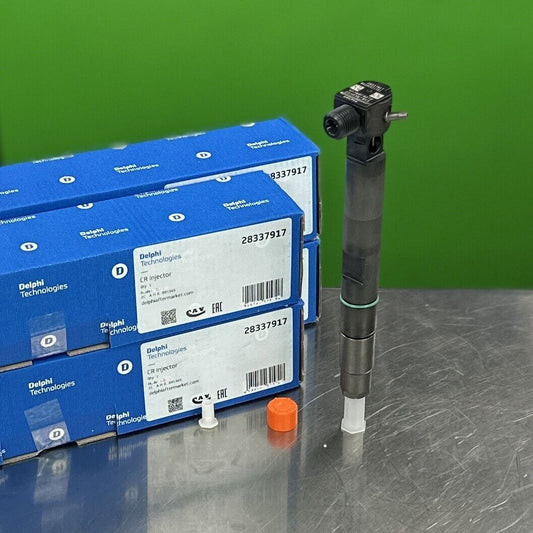4.5L 6.8L John Deere Common Rail Injector Troubleshooting: Diagnosing and Solving Common Problems
When it comes to troubleshooting common rail injectors in 4.5L and 6.8L John Deere engines, it's essential to have a solid understanding of the intricacies involved. These vital components play a crucial role in the fuel injection system, ensuring optimal engine performance and efficiency.
Common rail injectors are responsible for delivering precise amounts of fuel to the engine cylinders at the right time, contributing to smooth operation and power generation. However, like any mechanical part, they can encounter issues that may hamper their functionality and impact overall engine performance.
One of the key aspects of diagnosing common rail injector problems is recognizing the signs that indicate potential issues. Symptoms such as rough idling, decreased engine power, and increased fuel consumption are red flags that shouldn't be ignored. These indicators often point towards underlying injector malfunctions that need attention.
Diagnostic techniques play a crucial role in pinpointing the root cause of common rail injector problems. Visual inspection allows for a physical examination of the injectors, looking for signs of damage or wear. Pressure testing helps assess the injector's ability to deliver fuel at the required pressure levels, while electronic testing provides insights into the electrical components' functionality.
Common injector issues such as clogging, leakage, and wear are prevalent in 4.5L and 6.8L John Deere engines, affecting their performance and efficiency. Clogging can restrict fuel flow, leading to engine misfires and rough running, while leakage can result in fuel wastage and potential safety hazards. Wear over time can also impact injector performance, necessitating timely maintenance and repairs.
When it comes to troubleshooting common rail injector problems, a systematic approach is key to identifying and resolving issues effectively. By following step-by-step guidance and utilizing appropriate tools and techniques, diagnosing and solving injector problems in 4.5L and 6.8L John Deere engines can be a manageable task.
Understanding Common Rail Injectors
<>
Common rail injectors play a crucial role in the operation of 4.5L and 6.8L John Deere engines, serving as the heart of the fuel injection system. These sophisticated components are responsible for delivering precise amounts of fuel at high pressures to the engine cylinders, ensuring optimal combustion and performance. Imagine them as the skilled chefs in a gourmet kitchen, carefully measuring and injecting the perfect ingredients to create a masterpiece dish.
Within common rail injectors, fuel is stored at high pressure in a common rail or reservoir, ready to be injected into the combustion chamber when needed. This design allows for more efficient fuel delivery, resulting in improved engine efficiency, reduced emissions, and enhanced power output. It's like having a well-oiled machine that operates seamlessly to power your vehicle forward with precision.
Understanding the components of common rail injectors is essential for diagnosing and troubleshooting any potential issues that may arise. From the injector nozzle to the solenoid valve, each part plays a vital role in ensuring the proper functioning of the fuel injection system. Just like a symphony orchestra where every instrument has its unique sound but contributes to the harmonious performance, common rail injectors work in harmony to keep the engine running smoothly.
By grasping the inner workings of common rail injectors, mechanics and vehicle owners can appreciate the complexity and precision required for these components to operate flawlessly. It's akin to unraveling the mysteries of a well-crafted timepiece, where each gear and spring must work in perfect synchronization to keep time accurately. With this knowledge, troubleshooting and maintaining common rail injectors becomes more manageable, ensuring optimal engine performance and longevity.
Signs of Injector Problems
When it comes to common rail injectors in 4.5L and 6.8L John Deere engines, recognizing the signs of potential problems is crucial. These indicators can help you address issues early on and prevent further damage to your engine. So, what are the that you should be on the lookout for?
One of the most common signs of injector problems is rough idling. If your engine is vibrating or shaking more than usual when idling, it could be a red flag indicating injector issues. Additionally, decreased engine performance is another key indicator. If you notice a drop in power or acceleration, it could be attributed to faulty injectors affecting fuel delivery.
Another sign to watch out for is increased fuel consumption. If you find yourself filling up the tank more frequently than usual, it could be due to inefficient fuel injection caused by injector problems. Moreover, black smoke coming from the exhaust can also point towards injector issues, indicating incomplete combustion of fuel.
To further diagnose injector problems, pay attention to engine misfires or hesitations during acceleration. These issues can be linked to injector malfunctions affecting the fuel-air mixture ratio. Additionally, engine stalling or difficulty starting can be signs of severe injector problems that need immediate attention.
It's essential to address these signs promptly to prevent further damage to your engine and ensure optimal performance. By being vigilant and recognizing these symptoms early on, you can take the necessary steps to diagnose and resolve common rail injector issues in your 4.5L and 6.8L John Deere engines.
Diagnostic Techniques
When it comes to diagnosing issues with common rail injectors in 4.5L and 6.8L John Deere engines, precision is key. Utilizing various diagnostic techniques can help pinpoint the root cause of injector malfunctions and streamline the troubleshooting process. Let's explore some effective methods that can assist in identifying and resolving common rail injector problems.
One of the initial diagnostic techniques is visual inspection. By visually examining the common rail injectors for any signs of damage, corrosion, or leaks, you can gather valuable insights into their condition. Look out for any visible cracks, wear marks, or unusual buildup that may indicate underlying issues affecting the injector's performance.
Pressure testing is another crucial diagnostic method that can provide valuable data regarding the functionality of common rail injectors. By subjecting the injectors to pressure tests, you can assess their ability to deliver fuel at the required pressure levels. Any deviations from the specified pressure parameters can indicate potential problems that need to be addressed.
Electronic testing plays a significant role in diagnosing common rail injector issues accurately. By utilizing specialized diagnostic tools and equipment, you can analyze the electronic signals sent to the injectors and ensure proper communication between the engine control unit and the injectors. This method helps in detecting electronic malfunctions that may be causing injector performance issues.
Creating a comprehensive checklist of diagnostic steps can streamline the troubleshooting process and ensure that no crucial aspect is overlooked. By systematically following a diagnostic protocol that includes visual inspection, pressure testing, and electronic testing, you can efficiently identify and address common rail injector problems in 4.5L and 6.8L John Deere engines.
Common Injector Issues
Common rail injectors in 4.5L and 6.8L John Deere engines are prone to various issues that can affect engine performance and efficiency. One of the most common problems encountered with these injectors is clogging. Over time, deposits can build up inside the injector nozzles, obstructing the flow of fuel and affecting the spray pattern. This can lead to uneven combustion, reduced power output, and increased emissions.
Another prevalent issue is injector leakage. This occurs when the injector seals or O-rings deteriorate, allowing fuel to leak into the combustion chamber or engine bay. Not only does this result in fuel wastage, but it can also cause engine misfires, rough idling, and potential damage to other components. Detecting and addressing leakage promptly is crucial to prevent further complications.
Wear is also a common problem that affects the performance of common rail injectors. Continuous use and exposure to high pressures and temperatures can cause wear on critical components such as the nozzle, valve, or control plunger. This wear can lead to issues like poor fuel atomization, erratic injection timing, and ultimately, decreased engine efficiency. Regular maintenance and inspection can help identify wear early on and prevent more significant damage.
Moreover, electronic failures can also impact the functionality of common rail injectors. Issues with the injector driver module, wiring harness, or ECU can result in improper fuel delivery, injector misfiring, or complete injector failure. Proper diagnostic tools and expertise are required to troubleshoot and rectify electronic issues effectively.
In addition to these common problems, issues like fuel contamination, improper installation, or using low-quality fuel can also contribute to injector malfunctions in 4.5L and 6.8L John Deere engines. Addressing these issues promptly and following recommended maintenance practices can help prolong the lifespan of common rail injectors and ensure optimal engine performance.
Troubleshooting and Solutions
When it comes to troubleshooting common rail injector problems in 4.5L and 6.8L John Deere engines, it's crucial to follow a systematic approach to identify and resolve issues effectively. Let's dive into the step-by-step process of diagnosing and solving common injector problems:
- Visual Inspection: Start by visually inspecting the common rail injectors for any signs of physical damage, leaks, or clogs. Look for visible cracks, corrosion, or loose connections that could be causing issues.
- Pressure Testing: Perform a pressure test to check the fuel pressure delivered by the injectors. Low pressure can indicate a blockage or malfunction in the injector, affecting engine performance.
- Electronic Testing: Utilize electronic diagnostic tools to analyze the injector's electrical signals and performance. This method can help pinpoint specific injector problems such as faulty solenoids or wiring issues.
- Cleaning and Flushing: If clogging is identified as the main issue, consider cleaning or flushing the injectors to remove any debris or deposits that may be obstructing the fuel flow.
- Replacing Faulty Parts: In cases where the injectors are beyond repair, it may be necessary to replace faulty components such as nozzles, seals, or O-rings to ensure optimal performance.
By following these troubleshooting steps and implementing the appropriate solutions, you can effectively address common rail injector problems in 4.5L and 6.8L John Deere engines, restoring engine efficiency and performance. Remember, regular maintenance and timely intervention are key to preventing injector issues and ensuring smooth operation of your equipment.
<>Frequently Asked Questions
-
What are common rail injectors?
Common rail injectors are precision-engineered components that deliver fuel to the engine's combustion chamber at high pressure. They play a crucial role in the fuel injection system of 4.5L and 6.8L John Deere engines, ensuring efficient and optimal engine performance.
-
How can I identify injector problems?
Injector problems can manifest through various symptoms such as rough idling, decreased engine performance, and increased fuel consumption. If you notice any of these signs in your John Deere engine, it may indicate potential issues with the common rail injectors.
-
What diagnostic techniques are used for troubleshooting?
Diagnostic techniques for common rail injector troubleshooting include visual inspection, pressure testing, and electronic testing. These methods help in pinpointing the root cause of injector malfunctions and determining the necessary solutions.
-
What are some common issues affecting injectors?
Common problems that can affect 4.5L and 6.8L John Deere common rail injectors include clogging, leakage, and wear. These issues can lead to engine performance issues and must be addressed promptly to ensure optimal engine function.
-
How can I troubleshoot injector problems?
For troubleshooting common rail injector problems in John Deere engines, a step-by-step approach is recommended. By following specific guidelines and utilizing effective solutions, you can rectify injector issues and restore the engine's performance.



